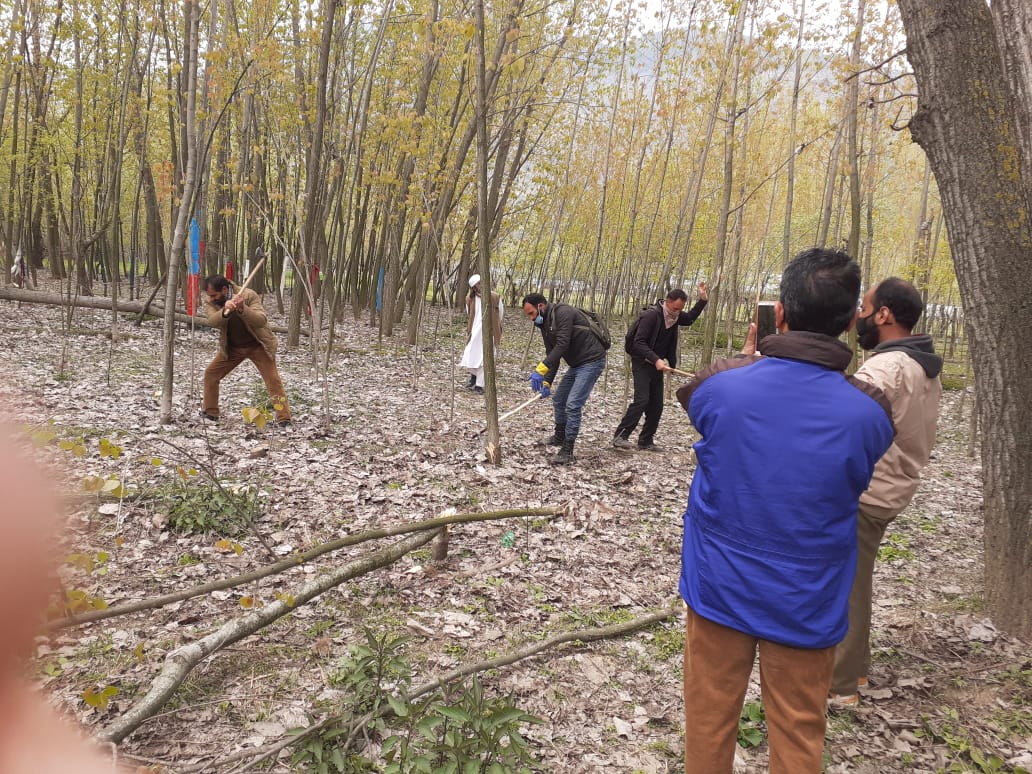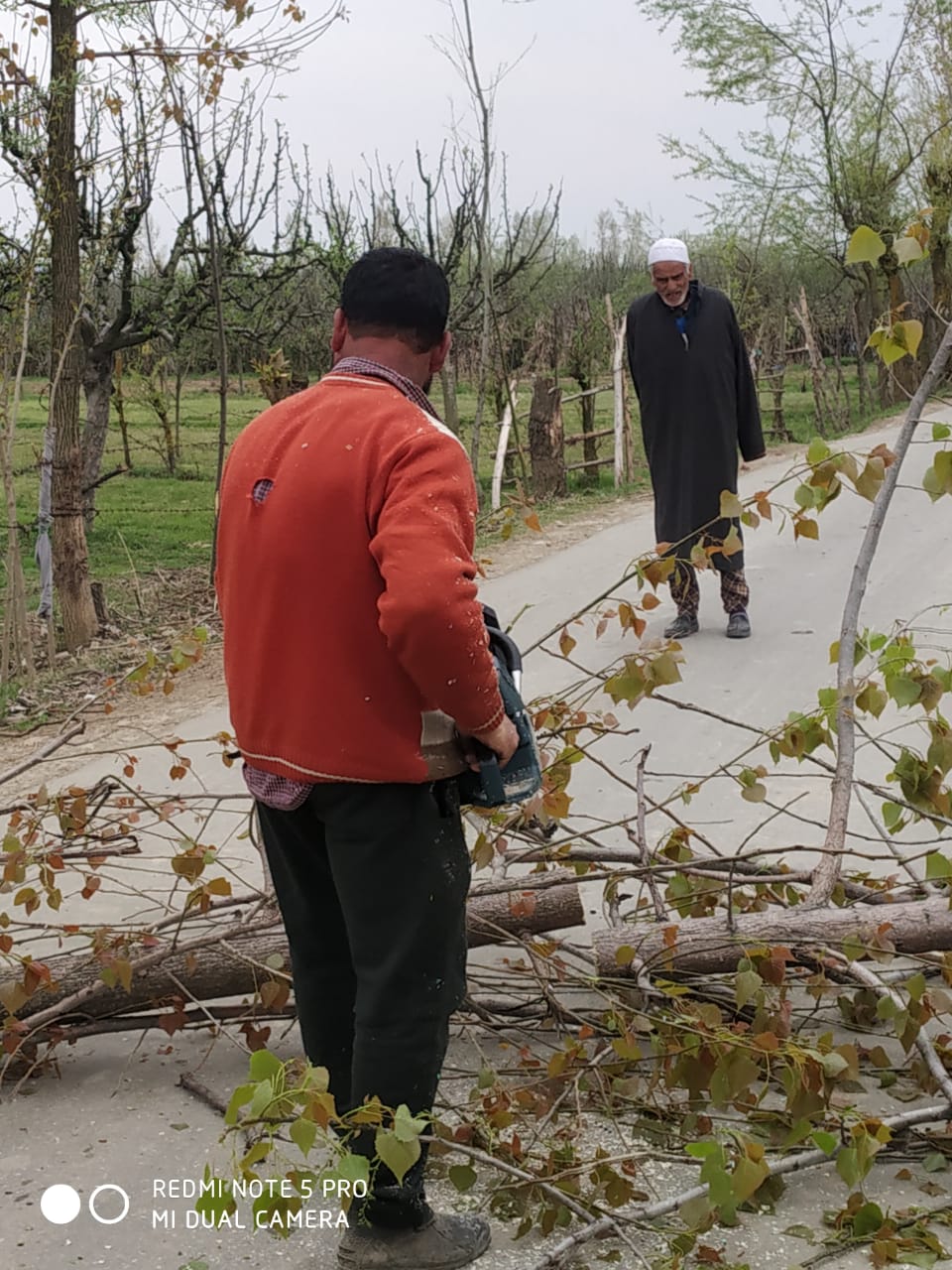
Culled for their supposed Covid-19 culpability, Kashmir’s female poplars aka ‘Roosi Phras’ are today facing a massive axe like never before—prompting many to question what they call a “kneejerk direction devoid of a scientific backing”. Photos Athar Parvaiz
Athar Parvaiz
District administrations across the Kashmir Valley have launched a massive female poplar tree felling and lopping programme on the directions of the divisional commissioner.
The ‘method behind the madness’, as many call it, is believed to be a growing sense in the administration and some civil society circles that female poplars can precipitate the Covid-19 crisis in Kashmir by spreading the novel coronavirus infections when they flower in the next few weeks.
“The process of felling of female poplars, as directed by higher-ups, is going on at full swing in our district,” said Showkat Aijaz Bhat, Kulgam’s deputy commissioner.
Tasked for the same tree-clearance in times of pandemic, officials at deputy commissioner’s office in Pulwama said that they’ve started the axing operation, based on the quick female poplar tree enumerating survey across the district.
A Curt Div Com Directive
On April 2, 2019, Divisional Commissioner of Kashmir, Pandurang Kondbarao Pole, had passed orders to district administrations for felling of female poplar trees (Populus deltoids) and chopping of their branches immediately before they start releasing their fluffy cotton-covered seeds during their flowering season in April and May.
“Social Forestry Department, Kashmir shall immediately start the process of felling of 42,000 poplar trees of Russian species at different locations-avenues in the form of strips,” Pole had directed.
“The department shall initially start lopping of all such trees and shall furnish action report within a week’s time.”
All the deputy commissioners of Kashmir valley shall ensure the lopping of female poplar trees by the private land owners within one week, the order further read.
“In case of non-compliance, the Tehsildars in consultation with the SFC (State Forest Corporation) shall cut down the female Russian species poplar trees and the costs/charges on account of the felling shall [be] met out from the auction proceedings of the felled down trees and the remaining amount shall be remitted in the government treasury. The concerned SSP (Senior Superintendent of Police) shall provide the necessary security arrangements.”
As the order fared on social media, it generated a mixed response.
While commoners swayed by certain media reports sent SOS-style tweets to officials for immediate poplar felling in their catchment area, the experts and environmental activists term such a move unscientific with unimaginable consequences on Kashmir’s environment.
Even then, information gathered by Kashmir Observer suggested that female poplar tree felling and lopping programme is going on at full swing in all the districts.
Irshad Ahmad, a nodal officer looking after the poplar clearance programme in Baramulla, said that 5000 female poplar trees belonging to the social forestry department are being lopped and felled whereas private poplar owners have also been issued directions for lopping and felling the female trees.

“We go to villages and make announcements through public address system urging farmers to lop and fell the female poplar trees,” Ahmad said, adding that all the Tehsildars are doing the same everywhere in Kashmir.
Bending a Straight Tree
Quoting Brajesh Mishra in his book, Kashmir: The Vajpayee Years, Indian spymaster, AS Dulat, writes, “the only thing straight in Kashmir is a poplar tree”. The observation, many in Kashmir believe, wasn’t entirely misplaced.
Ever since first introduced into Kashmir in 1982 as part of a World Bank aided project, Russian poplar has now almost replaced indigenous poplar.
But the growing springtime pollen pestering attributed to it has badly bended its image in the valley.
The indigenous variety, Koashur Phras (Kashmiri poplar tree), takes 40 to 50 years to grow fully while the imported species matures in about 15 years making it ideal for commercial growing.
Therefore, Russian poplar has become an important economic activity for Kashmiri farmers and generates livelihood for thousands of people.
Kashmir cannot afford to do without poplars because the wood provides low cost timber for roofing rafters and for making crates to transport valuable horticultural produce like apples, pear and peaches besides its utility for plywood industry.
In late April and May, however, cotton-covered seeds can be seen suspended air and settled on ground in streets, roadsides, markets and on the surfaces of the water bodies.
Much of this flu-inducing annoyance is being attributed to female poplar pollens in Kashmir. This common realization has paved a way for the court campaign against the tree.
In 2014, J&K High Court had passed directions to the state government to ban female poplar trees in Srinagar.
In subsequent years, the court asked the government to identify and fell female poplar trees across Kashmir given the health risks they pose.
Consequently, hundreds of thousands of female poplar trees have already been felled so far, most of them in 2016 and 2017.
‘No Scientific Justification’
Despite their economic and environment value, female poplar trees or Roosi Phras, have been identified as culprits for causing allergies in respiratory tract and spreading chest ailments in Kashmir though it’s yet to be established scientifically.
But, there is consensus that they are a nuisance.
While people have little idea if female poplars are blamable for spreading respiratory tract infections and allergies, they’re sure that their fluffy cotton-covered seeds act as a huge nuisance for people in April and May annually.
There’re millions of female poplar trees in Kashmir. Government estimates say that their number is around 20 million in all districts of Kashmir.
Experts of Botanical Sciences disagree with the view that female poplars should be declared culprits for causing infections when there’s no scientific proof in its support.
“There’s not a single study which has proved that seeds of female poplars cause respiratory infections,” said Anzar Khuru, a Botany professor at University of Kashmir.
“So, how can we say that they do unless we’ve some scientific evidence?”
But, it’s a fact that people complain of experiencing inconvenience during their flowering season, the professor added.
“So, they need to be phased out gradually. Not in a single go,” he opined. “It’s not environmentally advisable.”
Another expert, Abdul Hamid, observed that the seed in itself is not allergic, but the cotton-like covering might be carrying some allergic pollen of other plants such as walnut from one place to other which are hazardous.
“But, it’s easy to ward off the effect [of fluff] by wearing a mask for 15 days to a month,” Hamid suggested.
“The trees give out tons of oxygen throughout the year and 80 percent of our fruit industry is based on poplar trees.”
However, he said, lopping of upper branches of female poplars is better way or to propagate male ones and cut the females in phased manner.

A senior Pulmonologist, while requesting anonymity, said that number of respiratory ailments certainly spikes in April and May, but, he said, female poplars alone can’t be blamed for it without evidence.
Interestingly, a 2017 study by Government Medical College, Srinagar had identified dust as the biggest causative agent for respiratory ailments in Kashmir, stating, ‘it causes infections in 93 percent of the population’.
The study further revealed that the cotton-covered seeds of female poplars can cause allergic reactions in less than 20 percent of the population as compared to pollen from common grass which is likely to cause allergic reactions in 74 percent population while pollen from pine and Chinar trees can cause allergic reactions in around 60 percent of the population.
So, are the female poplars wrongly blamed?
Mudassir Shah, who teaches Botany in a higher secondary school in Sopore, said in a lighter vein that these poor trees are being subjected to gender discrimination.
“Gender bias against female poplars has reached a new high as government has ordered their speedy removal,” Shah said.
But while the tree destruction is already underway, many in locked down Kashmir now fear that they might step out in a lesser green Kashmir, once the plague will wane and vanish.
Follow this link to join our WhatsApp group: Join Now
Be Part of Quality Journalism |
Quality journalism takes a lot of time, money and hard work to produce and despite all the hardships we still do it. Our reporters and editors are working overtime in Kashmir and beyond to cover what you care about, break big stories, and expose injustices that can change lives. Today more people are reading Kashmir Observer than ever, but only a handful are paying while advertising revenues are falling fast. |
| ACT NOW |
| MONTHLY | Rs 100 | |
| YEARLY | Rs 1000 | |
| LIFETIME | Rs 10000 | |













